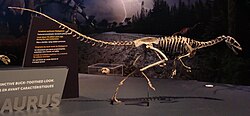Masiakasaurus
|
Masiakasaurus Temporal range: Late Cretaceous, 70 Ma |
|
|---|---|
 |
|
| Reconstructed skeleton, Royal Ontario Museum, Toronto, Canada | |
| Scientific classification | |
| Kingdom: | Animalia |
| Phylum: | Chordata |
| Class: | Reptilia |
| Clade: | Dinosauria |
| Order: | Saurischia |
| Suborder: | Theropoda |
| Family: | †Noasauridae |
| Genus: |
†Masiakasaurus Sampson et al., 2001 |
| Species: | †M. knopfleri |
| Binomial name | |
|
Masiakasaurus knopfleri Sampson et al., 2001 |
|
Masiakasaurus is a genus of small predatory theropod dinosaurs from the Late Cretaceous of Madagascar. In Malagasy, masiaka means "vicious"; thus, the genus name means "vicious lizard". The type species, Masiakasaurus knopfleri, was named after the musician Mark Knopfler, whose music inspired the expedition crew. It was named in 2001 by Scott D. Sampson, Matthew Carrano, and Catherine A. Forster. Unlike most theropods, the front teeth of M. knopfleri projected forward instead of straight down. This unique dentition suggests that they had a specialized diet, perhaps including fish and other small prey. Other bones of the skeleton indicate that Masiakasaurus were bipedal, with much shorter forelimbs than hindlimbs. M. knopfleri reached an estimated adult body length of around 2 metres (6 ft 7 in).
Masiakasaurus lived around 70 million years ago, along with animals such as Majungasaurus, Rapetosaurus, and Rahonavis. Masiakasaurus was a member of the group Noasauridae, small predatory ceratosaurs found primarily in South America.
Masiakasaurus were small-bodied ceratosaurs that grew up to around 1.8 to 2 metres (5.9 to 6.6 ft) in length. The most distinctive characteristic of Masiakasaurus is the forward-projecting, or procumbent, front teeth. The teeth are heterodont, meaning that they have different shapes along the jaw. The first four dentary teeth of the lower jaw project forward, with the first tooth angled only 10° from horizontal. These teeth are long and spoon-shaped with hooked edges. They have carinae, or sharp edges, that are weakly serrated. Serrations are more evident in the posterior teeth, which are also recurved and laterally compressed. The margin of the dentary curves downward so that the tooth sockets of the front teeth are directed forward. The front teeth of the upper jaw are also procumbent, and the margin of the premaxilla curves slightly upward to direct them outward.
...
Wikipedia
